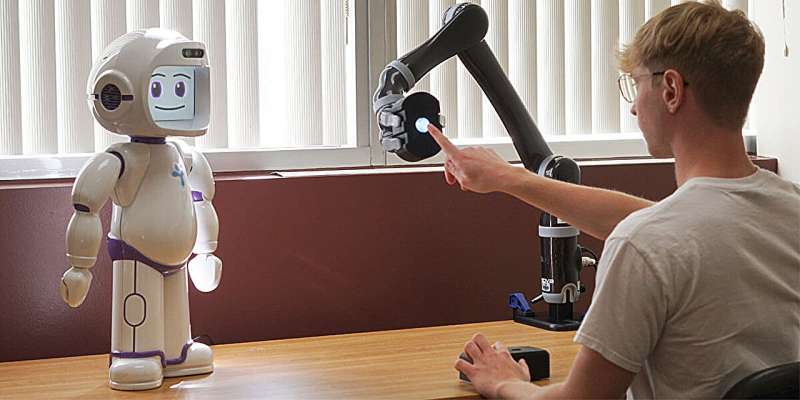New robotic system assesses mobility after stroke

A new robotic tool developed by a team of experts in computer science and biokinesiology could help stroke survivors more accurately track their recovery progress.
Annually, more than 15 million people worldwide experience a stroke, with three-quarters grappling with issues such as arm and hand impairment, weakness and paralysis. Despite the old adage to “Use it or lose it,” for stroke survivors, this can be easier said than done.
Breaking this habit, known as “arm nonuse” or “learned nonuse,” can improve strength and prevent injury. But, determining how much a patient utilizes their weaker arm outside clinical settings is challenging. In a classic case of observer’s paradox, necessitating covert measurements for natural behavior.
Now, USC researchers have developed a novel robotic system designed to collect precise data on how stroke survivors use their arms spontaneously. The pioneering method, outlined in a paper published in the November 15 issue of Science Robotics, uses a robotic arm to track 3D spatial information.
Machine learning techniques process the data, generating an “arm nonuse” metric, which could help clinicians accurately assess a patient’s rehabilitation progress. Throughout the challenge, a socially assistive robot (SAR) provides instructions and encouragement.
“Ultimately, we are trying to assess how much someone’s performance in physical therapy transfers into real life,” said Nathan Dennler, the paper’s lead author and a computer science doctoral student.
The study involved the combined efforts of researchers at USC’s Thomas Lord Department of Computer Science and the Division of Biokinesiology and Physical Therapy.
“This work brings together quantitative user-performance data collected using a robot arm, while also motivating the user to provide a representative performance thanks to a socially assistive robot,” said Maja Matarić, study co-author and Chan Soon-Shiong Chair and Distinguished Professor of Computer Science, Neuroscience, and Pediatrics. “This novel combination can serve as a more accurate and more motivating process for stroke patient assessment.”
Additional authors are Stefanos Nikolaidis, an assistant professor of computer science; Amelia Cain, an assistant professor of clinical physical therapy, Carolee J. Winstein, a professor emeritus and an adjunct professor in the Neuroscience Graduate Program, and computer science students Erica De Guzmann and Claudia Chiu.
Mirroring everyday use
For this study, the research team recruited 14 participants, initially right-hand dominant before the stroke. The participant placed their hands on the device’s home position—a 3D-printed box with touch sensors.
A socially assistive robot (SAR) explained the system’s mechanics and provided positive feedback, while the robot arm moved a button to various target locations in front of the participant (100 locations in total). The “reaching trial” began when the button illuminated, and the SAR cued the participant to move.
During the first phase, the participants were guided to reach for the button using their naturally preferred hand, simulating everyday use. During the second phase, they were instructed to use the stroke-affected arm, replicating actions performed in physiotherapy or other clinical settings.
Employing machine learning, the team analyzed three measurements to determine a metric for arm nonuse: arm use probability, time to reach, and successful reach. Detecting a noticeable difference in performance between the phases would suggest nonuse of the affected arm.
“The participants have a time limit to reach the button, so even though they know they’re being tested, they still have to react quickly,” said Dennler. “This way, we’re measuring gut reaction to the light turning on—which hand will you use on the spot?”
Safe and easy to use
Among chronic stroke survivors, the researchers observed significant variability in hand selection and in the time taken to reach targets within the workspace. The method demonstrated consistency across multiple sessions, and participants rated it as simple to use, earning above-average user experience scores. Additionally, all participants perceived the interaction as safe.
Participants felt that the system could be improved through personalization, which the team hopes to delve into in future studies. This includes exploring the integration of other behavioral data such as facial expressions and diverse tasks. Importantly, the researchers identified differences in arm utilization between participants, which could help health care professionals more accurately track a patient’s stroke recovery.
“For example, one participant whose right side was more affected by their stroke exhibited lower use of their right arm specifically in areas higher on their right side, but maintained a high probability of using their right arm for lower areas on the same side,” said Dennler.
“Another participant exhibited more symmetric use but also compensated with their less-affected side slightly more often for higher-up points that were close to the mid-line.”
As a physiotherapist, Cain said the technology tackled many issues associated with traditional methods of assessment, which “require the patient not to know they’re being tested and are based on the tester’s observation which can leave more room for error.”
“This type of technology could provide rich, objective information about a stroke survivor’s arm use to their rehabilitation therapist,” said Cain. “The therapist could then integrate this information into their clinical decision-making process and better tailor their interventions to address the patient’s areas of weakness and build upon areas of strength.”
More information:
Nathaniel Dennler et al, A metric for characterizing the arm nonuse workspace in poststroke individuals using a robot arm, Science Robotics (2023). DOI: 10.1126/scirobotics.adf7723
Citation:
New robotic system assesses mobility after stroke (2023, November 28)
retrieved 28 November 2023
from https://techxplore.com/news/2023-11-robotic-mobility-1.html
This document is subject to copyright. Apart from any fair dealing for the purpose of private study or research, no
part may be reproduced without the written permission. The content is provided for information purposes only.
For all the latest Technology News Click Here
For the latest news and updates, follow us on Google News.

